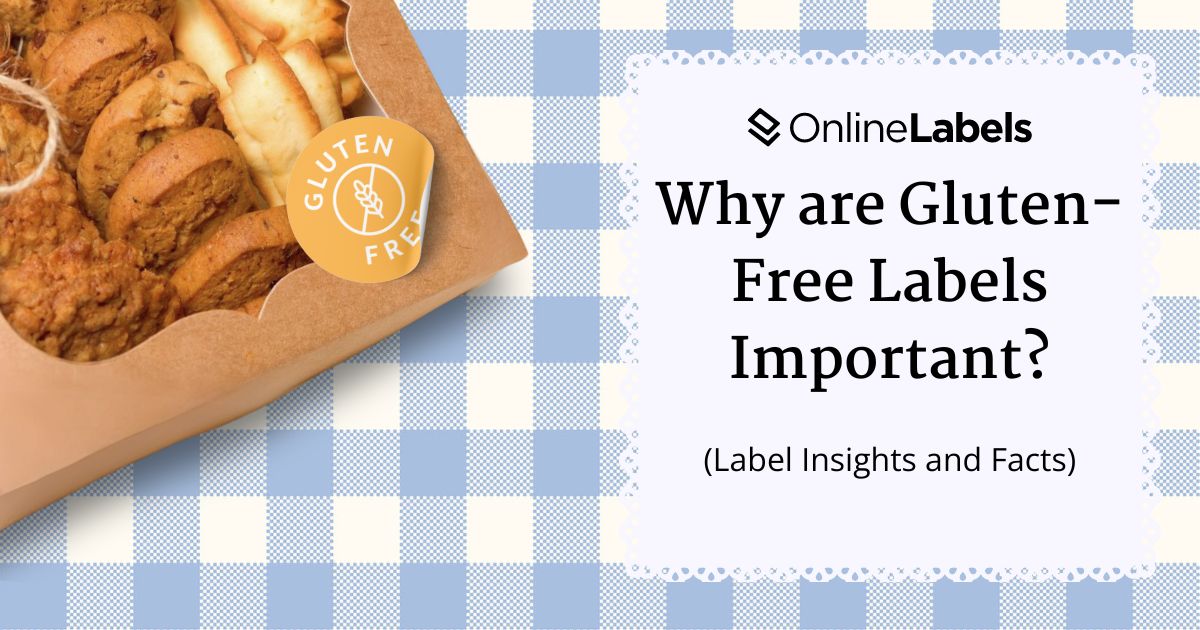Why Are Gluten-Free Labels Important?

Living with a gluten allergy can be a challenging journey since it's filled with dietary restrictions and constant selection over what one consumes. This can impact daily life, whether it's celiac disease, a non-celiac gluten sensitivity, or a wheat allergy. However, the rise of gluten-free products has opened new possibilities for those affected, making it easier to maintain a safe and healthy diet. Understanding gluten-free labels is crucial in navigating this landscape, ensuring individuals can make informed choices. This article will explore the intricacies of gluten allergies, where they came from, the expanding market of gluten-free products, and how to understand and use gluten-free labels in your business.
Understanding Gluten and Gluten Allergies
What is Gluten?
To understand gluten-free labels, we must answer an important question: what exactly is gluten?
Gluten is a composite of proteins found in wheat and related grains such as barley and rye. It consists primarily of two proteins: gliadin and glutenin. When flour is made from these grains mixed with water, gluten forms a sticky network that gives dough elasticity and helps it rise and maintain its shape during baking.
Source of Gluten:
- Wheat is the most common source of gluten. It is found in various forms, such as wheat flour, whole wheat flour, semolina, and spelt. These are commonly used in bread, pasta, cereals, and baked goods.
- Barley contains gluten in the form of hordein. It is often used in malted products, malt vinegar, and certain soups and stews.
- Rye contains gluten in the form of secalin. It is used in bread, rye beer, and certain breakfast cereals, such as Three Wishes and Honey Bunches of Oats.
Types of Gluten-Related Disorders
Gluten-related disorders encompass a range of conditions triggered by consuming gluten-containing grains. These disorders vary in their mechanisms and severity, affecting individuals differently. The main types of gluten-related disorders include:
Celiac Disease:
Celiac disease is an autoimmune disorder where the ingestion of gluten triggers an immune response. This response damages the lining of the small intestine, leading to malabsorption of nutrients.
- Symptoms: these can vary widely and may include gastrointestinal issues (such as bloating and abdominal pain), fatigue, skin rashes (like dermatitis herpetiformis), joint pain, and neurological symptoms.
Non-Celiac Gluten Sensitivity (NCGS):
Non-celiac gluten sensitivity is a condition where individuals experience symptoms similar to those of celiac disease but do not test positive for celiac antibodies or intestinal damage.
- Symptoms: common symptoms include abdominal pain, bloating, constipation, fatigue, headaches, joint pain, etc. However, in contrast with celiac disease, the conditions can improve on a gluten-free diet.
Wheat Allergies:
Wheat allergy is an immune-mediated reaction to proteins found in wheat, distinct from gluten-specific disorders.
- Symptoms can range from mild (such as hives, itching, or swelling) to severe (including difficulty breathing).
The Gluten-Free Product Market
The gluten-free product market has experienced exponential growth in recent years, driven by increasing awareness of gluten-related disorders and a growing preference for gluten-free diets. According to market research, the gluten-free product market is expected to grow from USD 6.79 billion in 2023 to USD 11.19 billion by 2031 due to the high demand for gluten-free products.
The Gluten-Free market can be divided into ten different categories, which include:
- Bread and Bakery Products: Gluten-free bread, rolls, bagels, muffins, and cakes made from alternative flour like rice flour, almond flour, or tapioca starch.
- Grains and Pasta: Gluten-free alternatives to wheat-based pasta include rice pasta, corn pasta, quinoa pasta, and products made from gluten-free grains like quinoa, buckwheat, and amaranth.
- Snack Foods: Gluten-free snacks such as chips, pretzels, crackers, popcorn, rice cakes, and granola bars made without wheat or gluten-containing ingredients.
- Cereals and Breakfast Foods: Gluten-free cereals, oatmeal (labeled gluten-free), granola, and breakfast bars made from gluten-free oats or other grains.
- Flours and Baking Mixes: Gluten-free flour blends (e.g., rice flour, sorghum flour, tapioca flour), baking mixes, pancake mixes, and ingredients for baking without gluten.
- Dairy and Dairy Alternatives: Milk, cheese, yogurt, and dairy-free alternatives like almond milk, coconut milk, and soy-based products labeled gluten-free.
- Frozen Foods: These include gluten-free frozen meals, pizzas, breaded chicken tenders, and desserts, often labeled gluten-free to indicate safe consumption.
- Condiments and Sauces: Gluten-free sauces (e.g., soy sauce labeled gluten-free), salad dressings, marinades, and condiments without gluten-containing ingredients.
- Beverages: These include gluten-free drinks like coffee, tea, juices, and sodas, as well as alcoholic drinks like wine and distilled spirits (though some flavored varieties may contain gluten).
- Snack Bars and Energy Bars: Gluten-free snack bars, protein bars, and energy bars made from gluten-free ingredients like nuts, seeds, and dried fruits.
These categories encompass a wide range of products designed to meet the dietary needs of individuals with gluten-related disorders or those opting for a gluten-free lifestyle. Consumers should check labels carefully and look for certifications to ensure products are truly gluten-free and safe for consumption.
When to Use Gluten-Free Labels for Your Products
Knowing when and how to use a gluten-free label is essential to ensure regulations are followed and build trust with the audience. Requirements to consider when labeling products with gluten-free labels include government regulations, ingredient analysis, and testing.
Government Regulations and Guidelines
The Food and Drug Administration (FDA) has established guidelines for gluten-free labeling in the United States. According to FDA regulations, products labeled as gluten-free contain less than 20 ppm of gluten. This standard aligns with international practices and provides consistency for consumers. However, it is essential to understand government regulations and guidelines regarding gluten labels.
How Does The FDA Define a "Gluten-Free" Product?
The FDA considers products to be "gluten-free" when they have inherently gluten-free ingredients, like all fresh fruits and vegetables, or don't contain ingredients that are:
- Regular testing: implement regular testing to verify that your products meet the gluten-free standard. This might involve batch testing and working with certified laboratories.
- Educate your team: if you’re working with a large group of people on the production, packaging, and marketing of the products, you should be educated about which products can be labeled gluten-free to prevent packaging mistakes.
How to Read Gluten-Free Labels
When reading labels on food packaging, look for specific phrases that indicate a product is gluten-free. These phrases denote that the product meets the defined standards for gluten content and has undergone testing to ensure compliance.
However, it's essential to be aware of common misconceptions when it comes to food labels:
- Wheat-free vs. gluten-free: a product labeled as wheat-free does not necessarily mean it is gluten-free. Wheat is just one source of gluten, and products may contain barley, rye, or oats, which could contain gluten unless labeled gluten-free.
- Made in a facility that processes wheat/gluten: this type of label indicates potential cross-contamination with gluten-containing grains during manufacturing. While helpful for those with gluten sensibilities, it may not be safe for individuals with celiac disease or severe gluten allergies.
- Gluten-free: a product label that strictly doesn't have or is processed with gluten. This type of label is helpful for audiences that are exclusively allergic to gluten.
Food Label Solutions for Gluten-Free Products
Gluten is a unique food composite that can represent a challenge for consumers and food producers. By understanding gluten allergies and the details behind gluten-free labels, businesses can not only choose to cater their products to a growing demand but also build trust and loyalty among their customers. Staying informed about government regulations, ensuring rigorous testing to prevent cross-contamination, and educating teams on best practices are essential in maintaining gluten-free products' integrity.
Shop gluten-free labels and our full collection of diet and allergy labels today.


